Space Shuttle Atlantis launched from Kennedy Space Centre on 8th July 2011. Despite light rain and cloudy skies, meteorological conditions were safe for a successful departure into orbit.
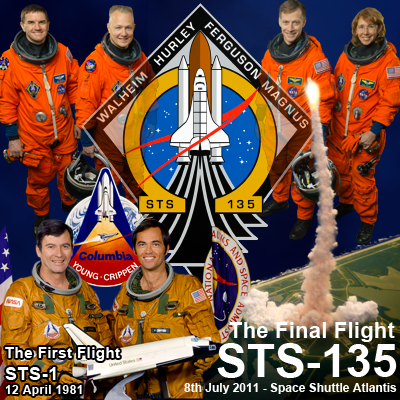 Space Shuttle Atlantis is the last orbital vehicle of a fleet of five spacecraft that form part of NASA’s 30-year Space Shuttle Programme. The other orbiters are: Columbia, Challenger, Discovery and Endeavour. The first two lost in fatal accidents that highlight the dangers that the programme has to face at every stage of its performance.
Space Shuttle Atlantis is the last orbital vehicle of a fleet of five spacecraft that form part of NASA’s 30-year Space Shuttle Programme. The other orbiters are: Columbia, Challenger, Discovery and Endeavour. The first two lost in fatal accidents that highlight the dangers that the programme has to face at every stage of its performance.
Mission 135 marks the end of one of the biggest accomplishments of humankind; the construction of the International Space Station (ISS), an artificial environment that supports human life outside Earth’s atmosphere.
The end of the building phase is the beginning of the productive period of the ISS, a space post dedicated entirely to scientific research. A multinational collaborative effort in space exploration fuelled by the recognition that the future of our species may potentially rely on finding habitable solutions outside our planet.
Since the 1980s there has been an explosion of technologies that used the services of the Space Shuttle Programme, from transporting provisions to the ISS to delivery and retrieval of equipment and satellites from orbital altitudes.
On this mission, Commander Chris Ferguson and Pilot Doug Hurley teamed-up with Mission Specialists Sandy Magnus and Rex Walheim in a 12-day excursion to the ISS. They will have the following objectives:
-
 Transport of “Raffaello,” the multi-purpose logistics module (MPLM), filled with 9 tonnes of supplies, experiments and spare parts for the ISS. A combined effort of NASA (National Aeronautics and Space Administration) and ASI (Agenzia Spaziale Italiana). This unit acts as a “moving van” to ferry cargo back and forth to the station. The crew will bring back debris and material no longer required at the station.
Transport of “Raffaello,” the multi-purpose logistics module (MPLM), filled with 9 tonnes of supplies, experiments and spare parts for the ISS. A combined effort of NASA (National Aeronautics and Space Administration) and ASI (Agenzia Spaziale Italiana). This unit acts as a “moving van” to ferry cargo back and forth to the station. The crew will bring back debris and material no longer required at the station. - Delivery of the Advanced Recycle Filter Tank Assembly (ARFTA), a titanium tank containing a bellows made of Hastelloy, the only materials known to withstand the corrosive effects of concentrated pre-treated urine/brine. Its function is to collect residue left over from extracting water from astronaut urine, a part of the station’s Water Recovery System (WRS), which produces purified potable water from crew urine.
- Delivery of the Robotic Refuelling Mission (RRM), an experiment to evaluate procedures of robotically refuelling satellites in space, even those not designed to be serviced. This mission as developed between NASA and the Canadian Space Agency (CSA). This will lay the foundation for future robotic servicing missions.
- Transport of the Lightweight Multi-Purpose Carrier (LMC) that will be used to return a failed Ammonia Pump from the ISS
- Carry the cryogenic transportation freezer GLACIER to carry experiment samples.
- Transport many experiments including a materials experiment to be installed outside the station.
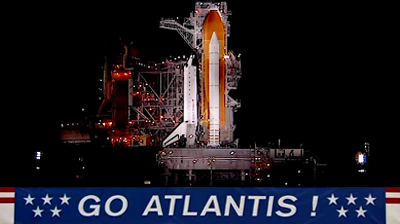 The crew of STS-135 will support a spacewalk carried out by members currently stationed at the ISS.
The crew of STS-135 will support a spacewalk carried out by members currently stationed at the ISS.
Flight Engineers Michael Fossum and Ron Garan will perform one spacewalk on the fifth day of the mission. On this occasion they will test a new procedure tried out by the previous mission in order to cut down the use of oxygen in preparation for the spacewalk. Instead of spending the night before the procedure in the low pressure capsule “Quest,” they will breathe pure oxygen for an hour while the pressure is lowered. Then they will put on their spacesuits and perform light exercise to increase their metabolic rate and purge nitrogen from their bloodstream.
 During the 6.5 hour spacewalk the astronauts will retrieve the failed pump module, install the Robotic Refuelling Mission experiment and deploy materials for another experiment.
During the 6.5 hour spacewalk the astronauts will retrieve the failed pump module, install the Robotic Refuelling Mission experiment and deploy materials for another experiment.
In addition to their activities, the mission is taking many experiments to the station and also bringing some back to Earth.
Update on the mission
The routine inspection of the heat shield using Canadarm2 on board the Shuttle revealed no visible damage to the tiles during launch. Similar results were found in the analysis of photos taken with the 3 ISS cameras (400, 800 and 1000mm lens cameras) during the Shuttle’s roll-over or “rendezvous pitch” manoeuvre.
 After a flawless docking to the ISS, the 12th of Shuttle Atlantis, the crew of astronauts were welcomed by their colleagues at the station.
After a flawless docking to the ISS, the 12th of Shuttle Atlantis, the crew of astronauts were welcomed by their colleagues at the station.
The team on the ground was watching a piece of debris travelling in an orbit close to that of the space station. They feared a “conjunction” or moment of maximum proximity to the station to happen on the day of the spacewalk. Interestingly, the docking of the Shuttle to the station resulted in a change in trajectory sufficient to avoid that of the approaching debris.
The spacewalk went well with almost all tasks completed successfully. Thanks to the live transmission, courtesy of NASA-TV, the world was able to witness the complexity and exhausting job that the astronauts have to do in those continuous 6.5hr in space. After almost 250 spacewalks in history, the delicate procedure now runs smoothly with minimal problems.



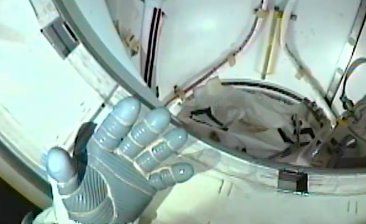
The morning after the spacewalk, the astronauts woke-up to the tune of the song “Rocket man” followed by a short message from its author Sir Elton John, who acknowledged the 3 decades of success of the Shuttle Space Programme. The crew also had the chance to show off their floating skills during interviews with the media, interested in the progress of the last mission of the programme.




Meantime on Earth, in the Atlantic coast at Cape Canaveral in Florida; a convoy of vessels conducted the final recovery of Solid Fuel Rocket Boosters in the programme, the only re-usable parts besides the shuttle. The recovery convoy was led by a boat marking the occasion blowing its sirens and shooting water towards the sky as they travelled to port for the last time.
The last duties of Mission STS-135 revolved around transporting cargo to and from the station, ensuring that the ISS is sufficiently supplied for up to one year.
 Seven days after docking to the space station the astronauts on board ISS got together for a farewell ceremony before preparation for undocking.
Seven days after docking to the space station the astronauts on board ISS got together for a farewell ceremony before preparation for undocking.
Commander Chris Ferguson presented the crew of Expedition-28 living at ISS a signed model of the Shuttle that will stay next to the entry hatch, as a monument to the accomplishments of the Space Shuttle Programme.
The crew also left an American Flag that flew on the first Space Shuttle Mission, STS-1, which will be placed on top of the hatch that leads to Atlantis. The flag will be returned to Earth by the next American astronaut launching on a new generation US vehicle, marking the continuation of space exploration beyond the age of the Space Shuttle Programme.





The crew of Atlantis carried along their mission a symbolic national flag from the Miami Dade Police Department. It will be returned upon landing with the added value of having been to almost as far as humans can go.
On Tuesday 19th July, undocking proceeded without a hitch, followed by a flight around the station. This time the station rotated 90 degrees to allow viewing areas that are usually missed by this manoeuvre.
 Two separation burns moved the Shuttle away from the ISS and closer to our planet. The crew then made another stop to inspect the heat shield for damage that might have occurred while docked to the station.
Two separation burns moved the Shuttle away from the ISS and closer to our planet. The crew then made another stop to inspect the heat shield for damage that might have occurred while docked to the station.
The next day, before preparations for re-entry burn, Atlantis made its 180th deployment: the mini-satellite PICO, its purpose is to take the last pictures of the Shuttle as it re-enters our atmosphere. This satellite weights 4kg and measures 12x12x20cm; it is covered with solar cells to test a new solar cell technology. During flight it was stored in a small canister inside the cargo bay, under Canadarm-1 and the KU-Band communications antenna (golden structure in the pictures), which helped downlink the excellent television images to the control room and NASA-TV.
On the same date, 20th July in 1969, Neil Armstrong walked on the moon. Celebrating this occasion the astronauts had their last interview with the media and did a great job as ambassadors of the space programme. Their message was: “Take a look back at the landing of Atlantis and make a memory because you will never see the landing of a Space Shuttle again.”




Landing
 Early morning on Thursday, 21st July 2011, Atlantis proceeded with the final de-orbit burn to slow down the spacecraft, which is done with the spacecraft moving backwards. Then it turned around and lifted the nose to expose the thermal shield to the zone of most friction as it entered the atmosphere. At that point, the heat shield was put to test when temperatures around the Shuttle -reached 13,800 degrees Celsius (25000 F).
Early morning on Thursday, 21st July 2011, Atlantis proceeded with the final de-orbit burn to slow down the spacecraft, which is done with the spacecraft moving backwards. Then it turned around and lifted the nose to expose the thermal shield to the zone of most friction as it entered the atmosphere. At that point, the heat shield was put to test when temperatures around the Shuttle -reached 13,800 degrees Celsius (25000 F).
In its descent, the spacecraft slowed down from 24 to 14 times the speed of sound as it travelled across the Gulf of Mexico towards Cape Canaveral. It flew by over Naples, Florida at 6 times the speed of sound; 5 minutes later, Atlantis went sub-sonic and everyone around could hear the twin sonic booms.
Pilot Doug Hurley took over control of the aircraft until touch down, culminating the mission at the official elapsed time of 12 days 18 hours 28min and 14 seconds.


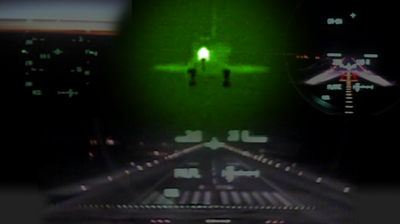
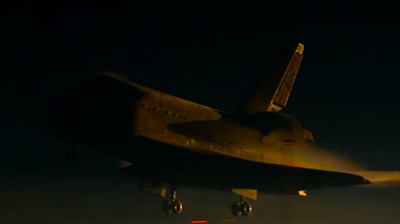
Space Shuttle Atlantis
 The Space Shuttle Atlantis was the fourth Orbiter Vehicle designed by the company Rockwell International in 1985. Since then it has served the programme in a large number of achievements and number first in the following:
The Space Shuttle Atlantis was the fourth Orbiter Vehicle designed by the company Rockwell International in 1985. Since then it has served the programme in a large number of achievements and number first in the following:
- First to deploy a probe to another planet (Magellan towards Venus, also Galileo to the outer planets including Jupiter)
- First to dock to the space station Russian MIR
- First shuttle with glass cockpit
Some of the highlight of its many years of service include:
- 1985, 3 October: First flight carrying Mission STS-51j that deployed two DSCS-III (Defence Satellite Communications System) satellites into stationary orbit
- 1985 second mission STS-61b: Deployed 3 communications satellites: MORELOS-B, AUSSAT-2 and SATCOM KU-2
- 1986 Challenger accident: Grounds the Shuttle fleet
- 1988, 2 December: Deployed the Lacrosse 1 satellite, for the US National Reconnaissance Office (NRO) and the Central Intelligence Agency (CIA)
- 1989, 2 missions: The first one to deploy the Magellan spacecraft to capture images of Venus; and Galileo released towards Jupiter
 1990, 2 missions to deliver satellites for the Department of Defence: The Misty reconnaissance satellite and a secret Magnum ELINT (ELectronic INTtelligence) gathering satellite.
1990, 2 missions to deliver satellites for the Department of Defence: The Misty reconnaissance satellite and a secret Magnum ELINT (ELectronic INTtelligence) gathering satellite.- 1995, 29 June, the first Mission to dock on the Russian MIR, starting the cooperation of the two former enemy countries in the project SPACELAB/MIR
- 2000 start of the ISS assembly missions with the first component, followed by missions dedicated to this purpose.
- 2009, 11 May, Historic Hubble Space Telescope final Servicing Mission replacing and adjusting the optics to maximize its performance.
"Launching Our Dreams: A Shuttle Retrospective" and "STS-135 Mission Overview"
Atlantis Art

Last chance to see Atlantis from your backyard !
NASA offers a service to help you track the progress of the ISS and other satellites in the night sky. All you need is a pair of binoculars and ideally somewhere solid to lean on. The service is “Sighting Opportunities” and can be found here.
Find your country and city using the Search field and a table will tell you when, and where to look for the spacecraft in the sky.
References
¤ ‘History of the Space Shuttle’ (2011). NASA. [Online]. Available here. (Accessed: 08 July 2011).¤ ‘Mission STS-135’ (2011). NASA. [Online]. Available here. (Accessed: 08 July 2011).
¤ ‘NASA HD-TV’ (2011). NASA-TV. [Online]. Available here. (Accessed: 18 July 2011).
¤ ‘Sighting Opportunities’ (2011). NASA. [Online]. Available here. (Accessed: 19 July 2011).
¤ ‘Space Shuttle Atlantis’ (2011). Wikipedia. [Online]. Available here. (Accessed: 18 July 2011).